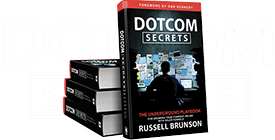Virtual selling has been on the rise for at least several years before the Covid-19 virus hit.
However, when the global pandemic started, businesses around the world were forced to completely abandon field sales.
Unsurprisingly, the popularity of virtual sales skyrocketed, since, for most companies, remote selling became the only way to sell their products. By May, there was a 163% increase in virtual sales.
And it seems that virtual selling is here to stay. That’s why you need to get good at it!
Here’s what we are going to discuss today:
- What is virtual sales?
- What are the biggest challenges of virtual sales?
- What do buyers think about virtual sales?
Plus, we will share the biggest virtual selling mistakes (according to the buyers), as well as ten tips that will help you avoid them.
Want to close more sales over Skype, Zoom, or Google Meet?
Continue reading…
What Is Virtual Sales?
Sales are separated into two categories:
- Inside sales. This means selling without leaving the office. Inside sales used to be limited to phone sales, but now also include selling via email, social networks (e.g. LinkedIn), as well as via audio and video call software (e.g. Skype).
- Outside sales. This means leaving the office and meeting prospects face-to-face.
Virtual sales, also known as remote sales, is a form of inside sales where you sell through Skype, Zoom, GoogleMeet, etc.
It includes both audio and video calls, but when people use this term, they usually refer specifically to video calls.
What Are the Biggest Remote Selling Challenges?
In May 2020, the RAIN Group Center for Sales Research conducted a global study of 528 buyers and sellers.
They were surprised by just how challenging the sellers found virtual selling.
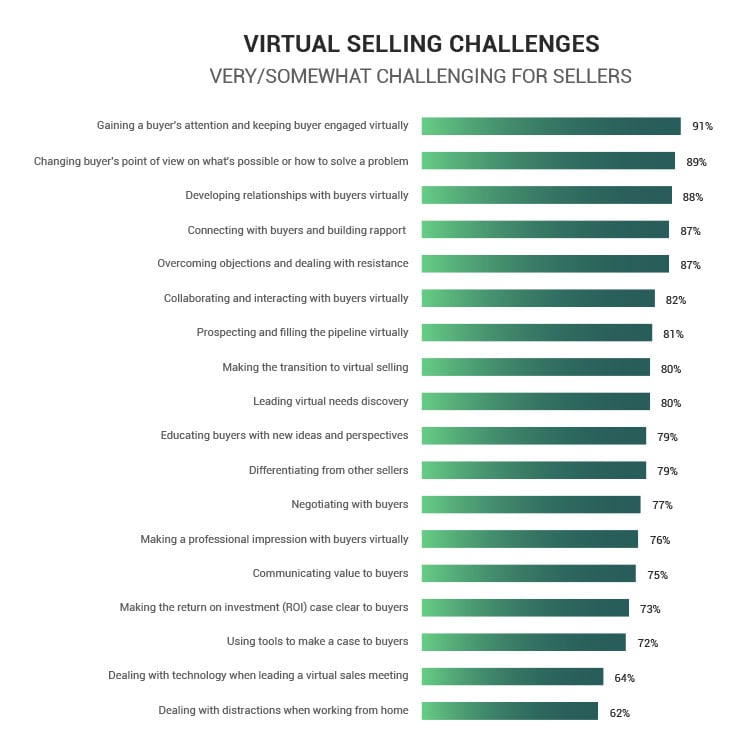
As you can see, the top three challenges were:
#1 Getting the Buyer’s Attention and Keeping Them Engaged
When you are talking to someone face-to-face, it’s much easier to keep their attention, since there are fewer distractions. Plus, there’s the social pressure to be polite.
However, when you are having a video call with someone, keeping their attention becomes much more difficult because there are more distractions. People just aren’t used to staying focused when online.
Moreover, being distracted on a video call seems more acceptable, so there’s less social pressure to be polite.
It’s important to account for this when preparing your virtual sales presentation.
You need to hook the prospect immediately, keep their attention by providing a ton of value, and keep them engaged by asking them questions.
#2 Changing the buyer’s point of view
It’s more difficult to establish rapport with the prospect remotely, which is why it’s also harder to change the buyer’s mind on important issues.
This is a serious problem for those who offer consulting services. In order to provide value, you need to solve a problem, but you can’t do it if the prospect is unwilling to consider the solution you are proposing.
That’s why you may want to put extra effort into establishing your credibility when selling remotely.
This starts with your online presence: a professional website, a polished LinkedIn profile, etc.
You also want to offer social proof such as customer testimonials and case studies.
It also makes sense to mention the media outlets you have been featured in.
All this will help you establish your credibility in the eyes of the potential customer before the sales call.
Meanwhile, during the call, you want to be professional, confident, and empathetic, so that the prospect would be inclined to trust you.
#3 Developing Relationships With Buyers
The fact that establishing rapport remotely is more difficult than doing it in person means that building relationships with prospects can prove to be quite a challenge.
However, even if you can’t meet them face-to-face, the most important principle of creating a connection still applies: provide value.
You can do so through thoughtful email communication. Send them a message 1-2 times per month with a link to a piece of content that may interest them.
Note that these emails shouldn’t be thinly-veiled sales pitches, they should just be links to something that’s relevant to that person.
You can also keep an eye on their career. Follow them on LinkedIn and subscribe to their blog/podcast/YouTube channel/etc.
When they get a promotion, send them a congratulatory message. When they publish a piece of content that you like, pay them a compliment. Be genuine, though.
All this will help you build a relationship with them. Obviously, it makes it easier to sell to them, but it also allows you to expand your network.
And you never know what opportunities connections like that may bring in the future.
What Do the Buyers Think About Virtual Sales?
The RAIN Group Center for Sales Research also discovered that sellers were ineffective across the board.
Here’s what they asked the buyers:
- What were the main factors that influenced their purchase decisions?
- How effective the sellers were at meeting those requirements?
It quickly became clear that there was a huge gap between what the buyers needed and what the sellers provided:
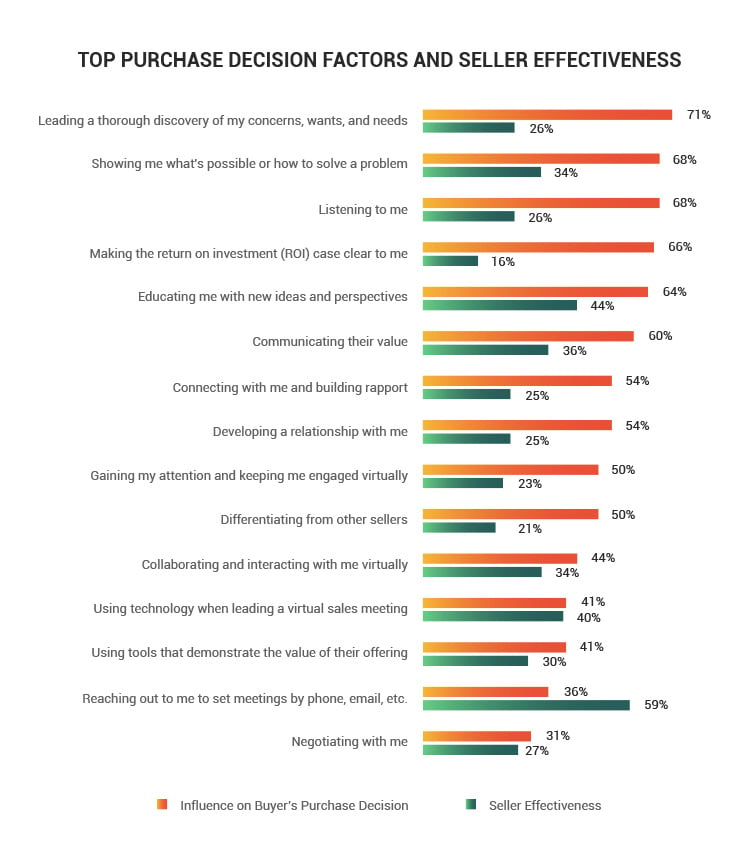
Let’s take a closer look at the top three purchase decision factors:
#1 Leading a Thorough Discovery of My Concerns, Wants, and Needs
Sellers don’t put enough effort into understanding the buyers.
Here’s how the prospects experience this:
“They want to sell me that, but a) I don’t need it, b) they don’t ‘get it’, and c) I don’t want to work with people that don’t focus enough on me.”
It’s best to assume that you don’t understand what the prospect wants until they themselves have expressed it.
Ask questions, listen to their answers, show genuine interest in them.
That way, you’ll demonstrate empathy, build rapport, and be able to better convey the benefits of your product.
The “50 Powerful Questions”guide may come in handy here.
#2 Showing Me What’s Possible or How To Solve a Problem
Sellers don’t present a clear solution to the problem at hand.
Here’s how the prospects experience this:
“The challenge is clear. The solution? They didn’t seem to have the right one/it didn’t make sense to me.”
This is likely due to one of these two issues:
- Product/market mismatch. It’s possible that the product doesn’t offer a viable solution to the problem.
- Pitch/market mismatch. It’s also possible that the product does offer a viable solution to the problem, but the potential customer can’t see it because the sales pitch doesn’t resonate with them.
So make sure that you have a product that solves the problem and that you know how to convey that to the prospect.
#3 Listening To Me
Sellers don’t make the buyers feel heard.
This is how the prospects experience this:
“I don’t want to work with them.”
No one wants to be seen as a walking dollar sign.
When you don’t take the time to listen to the prospect, you may give them the impression that this is how you see them. Is it any wonder that they are put off by that?
So, once again, ask questions, listen to the answers, show genuine interest in the potential customer.
Most importantly, treat the other person as a human being, not as a dollar sign.
These 10 Virtual Sales Tips Will Help You Avoid the Biggest Virtual Selling Mistakes!
The RAIN Group Center for Sales Research also asked the buyers what the top seller mistakes were.
Here are the results:
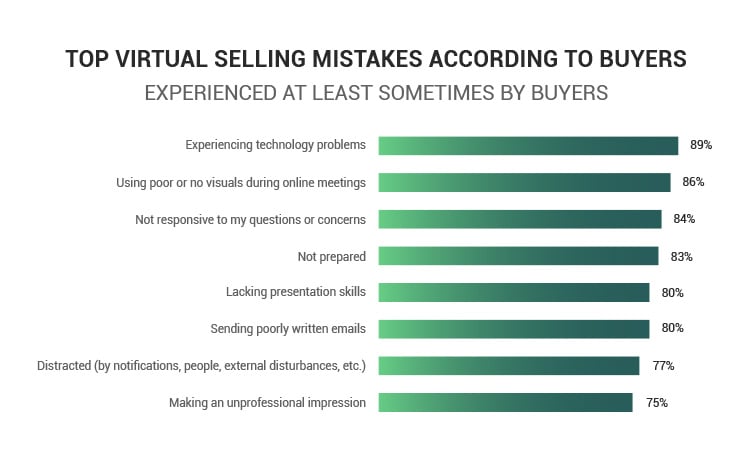
You can stand out from the crowd and make a great impression simply by avoiding these mistakes.
Here’s how…
#1 Get a Reliable, High-Speed Internet Connection
You know what is a likely cause of the “technology problems” that the prospects are so sick and tired of?
It’s the seller’s Internet connection.
It’s may be unreliable, slow, or both.
So make sure that your Internet connection can handle virtual sales calls.
#2 Pick the Right Software
Another source of “technology problems” are questionable software choices.
When it comes to virtual sales, you don’t want to be “trying out new things”, you want software that you can rely on.
Here are the three most popular options:
Skype
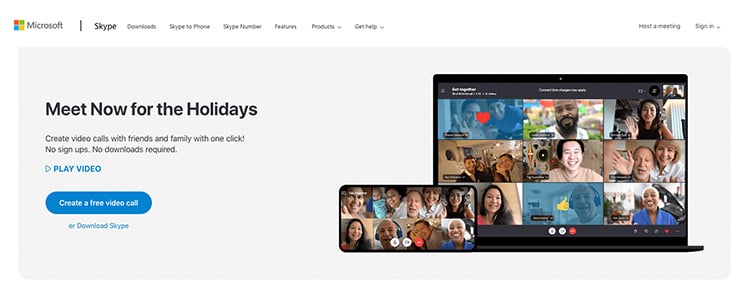
Skype is a company that was founded in 2003 and was acquired by Microsoft in 2011 for $8.5 billion
That is to say, it’s an established company that has a 17-year-long track record and is used by millions of people around the world every day.
Skype’s main advantage in the virtual sales space is its ubiquity. Your potential customers likely already have accounts and know how to use the software. Plus, it probably feels safe and familiar to them.
Meanwhile, its main drawback is the fact that it was designed for casual one-on-one calls, which means that it’s not the best option for holding a sales meeting with more than two participants.
That being said, if you want to talk to a prospect one-on-one, Skype may work well for that.
Consider creating a business account, though, so that your business contacts wouldn’t get mixed up with your personal contacts.
Zoom

Zoom is a company that was founded in 2011 and had an IPO in 2019. It was valued at $16 billion after the first day of trading.
They were interested in video conferencing since the beginning, with their first customer being Stanford University.
And that is the main advantage of Zoom. Want to hold a sales meeting with an entire team? That’s the software you want.
Meanwhile, the main disadvantage is its security issues, which the company is infamous for.
In fact, when the pandemic hit back in spring, its security was so bad that people could join someone else’s calls uninvited, which came to be known as zoombombing.
That being said, the company now takes security much more seriously, so this shouldn’t be an issue unless your sales call includes highly sensitive information.
Google Meet
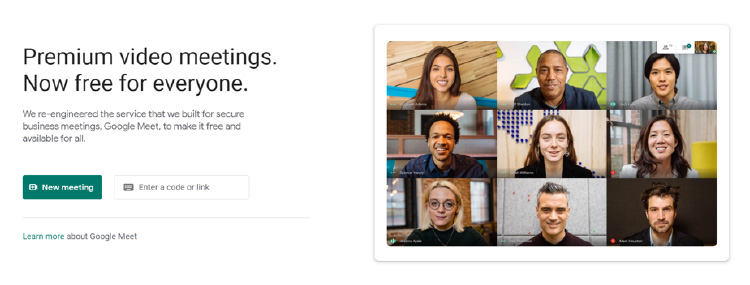
Google itself needs no introduction, but Google Meet is a feature that was released in 2017, then exploded in popularity during the pandemic.
It is free for everyone at the moment, but users with Google Workspace accounts get extra features.
Google Meet is a robust video conferencing software that can handle video calls with a ton of participants (e.g. Google Workspace starter plan allows for up to 100 members on video calls).
So if you need to hold a large sales meeting, it is an option that you want to consider.
#3 Invest in High-Quality Equipment
Low-quality equipment may also lead to “technological problems”.

You may want to invest in your:
- Laptop. Most laptops can handle video calls without an issue. Still, the more powerful your laptop is, the less likely you are to run into problems.
- Earphones. It’s best to use earphones for video calls because using your computer speakers may lead to annoying echoes.
- Microphone. This is arguably the most important piece of equipment. People are much more likely to overlook poor video quality than they are to overlook poor audio quality. You won’t be able to keep the prospect engaged if they can’t make out what you are saying. So get a professional-quality microphone.
It makes sense to upgrade your equipment to minimize the likelihood of it letting you down. It doesn’t have to cost a fortune, either.
#4 Have a System in Place
You don’t want to come across as someone who has never had a virtual sales meeting before.
That’s why you need to create a system for when a prospect agrees to have a video call:
Email templates
Prepare templates for every message that you need to send to a prospect. They should be professional and have a clear call to action.
Also, make sure to personalize them, because no one appreciates getting an obviously copy-pasted email.
Scheduling software
Ever tried to arrange a meeting via email?
Then you know that the back-and-forth can take ages. You don’t want that.
Use Calendly to create a calendar that shows when you are available, then share it with the prospect so that they could book the time that works best for them.
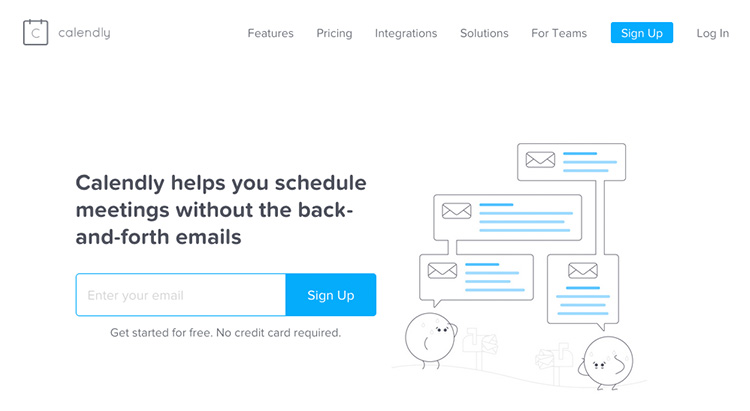
Follow-up procedures
You need follow-up procedures both for prospects that agree to buy your products and the ones who decide that they are not interested.
How will you get the former to finalize the purchase and how will you keep in touch with the latter in a way that’s respectful and adds value?
Sorting all this beforehand will help you make a great impression. Don’t fly by the seat of your pants!
#5 Insist on a Video Call
Let’s keep it real: we all feel a bit awkward about video calls.
You need to tidy up your apartment, you need to put on proper clothes, you need to make yourself look presentable… Why not just have an audio call instead?
It’s likely that the prospect feels that way as well, but you should nevertheless insist on a video call. Why?
- It’s easier to build rapport when you can see the other person.
- It’s easier to read the potential customers and adjust your sales presentation accordingly when you can see them.
- It’s easier to keep the potential customers’ attention because knowing that you can see them makes them more inclined to resist distractions.
Also, the necessity of making yourself and your environment look presentable can help you get into the right mental state.
After all, sitting in a messy kitchen in your pajamas doesn’t exactly put one in a go-getter, “Always Be Closing” mood.
#6 Have a Professional Setup
You need to make sure that your environment looks professional.
Of course, it’s ideal to make virtual sales calls from an office, but if you don’t have access to one, you may have to put in some effort to create a suitable space at home. What does that mean?

Tidy Background
It’s okay to call a potential customer from your house or your apartment, but it shouldn’t be too casual, meaning: no unmade beds, piles of clothes on the floor, or unwashed dishes in the background!
One simple solution to this can be to have your back to the wall or a bookshelf so that the potential prospect would only get an extremely limited view of your space.
It also makes sense to use the partial background blur function that is available on video conferencing apps.
Completely blurring the background might look weird, but partially blurring it can make you look more professional.
And don’t be tempted to use the pre-made backgrounds. They often don’t work well and look like an amateurish green screen. Just go with the partial blur on your actual background.
Lighting
Lighting has a huge impact on how you look on camera.
What you need to avoid is being lit:
- From behind because it makes it hard to see your face.
- From the sides and from right above you because the shadows might make your face look weird.
What you want is to be lit from the front, say, with a lamp that is right behind your laptop.
You may want to consider getting a filming light that can be attached to your computer.
Distractions
A few videos of cats, birds, and babies videobombing video calls have gone viral. And deservedly so. They are adorable.
You know what’s not adorable? When a potential customer can hear your phone ringing, pots clanking in the kitchen, or your aunt watching her favorite TV show. You should do your best to minimize distractions as much as possible.
Of course, under the pandemic restrictions, that’s not always possible, but you may want to ask the members of your household to try and keep the noise down when you are on a virtual sales call.
#7 Look Presentable
You should also make sure that you look presentable.
Now, “presentable” depends on the context, so you may want to put some thought into what is appropriate for each sales call.
For example, if the prospect is a CEO of a global corporation, then you may want to dress in a professional manner.
Meanwhile, if the prospect is a CEO of a scrappy Silicon Valley startup, then casual attire may work better.
Here’s an easy way to decide what to wear for a video call:
Would you be comfortable meeting this potential customer in person dressed like that?
#8 Use Visuals
As you may remember, “Using poor or no visuals during online meetings” was the second biggest virtual selling mistake cited by the buyers.
And it makes sense. It can be difficult to follow what the seller is saying without any visuals. This is especially true for complex products.
So invest in professional visuals that you can use in your virtual sales presentation.
#9 Test Everything Before the Call
You should always do a test call before the actual sales call.
It doesn’t have to be complicated. Just get a family member, a friend, or a coworker to call you using the software that you are going to use for the sales call.
Talk to them for five minutes.
What you want to know is this:
- Can you see and hear them?
- Can they see and hear you?
- How do you look on camera?
- Is there anything in the background that should be removed?
- Are there any background noises that should be addressed?
Doing a test like that doesn’t take much effort, but it can help you identify potential issues and correct them before you get on a call with the prospect.
#10 Study Sales!
Sales are sales.
Whether you are selling face-to-face, on the phone, or via video call, you need the same core skills.
Remember the chart showing the purchase decision factors and how effective the sellers were at meeting those requirements?
Well, most of those factors are basic sales skills, with a few exceptions that are specific to virtual sales:
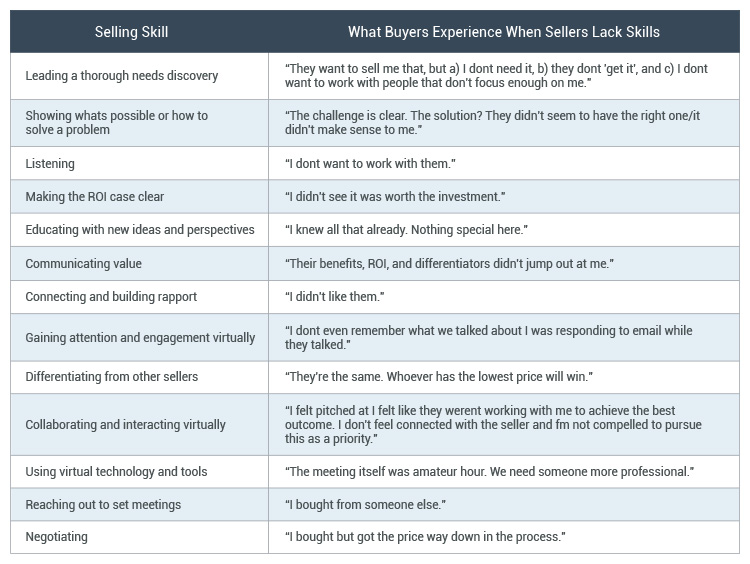
This means that you should study sales strategies, techniques, psychology, etc.
Want to be good at virtual sales?
Then get good at sales.
It’s that simple.
Conclusion
There’s no doubt that virtual selling is more challenging than face-to-face selling.
That being said, all the core sales principles that apply to selling in person apply to selling through a video call as well.
You need to:
- Establish rapport with the prospect.
- Show them how your product will make their life better.
- Present them with a clear call to action to close the sale.
You just have to figure out how to do all that in a virtual environment.
So don’t be intimidated by virtual sales. If you can sell in person, you can sell on Zoom as well!


